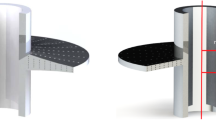Abstract
This work introduces a simple method of analysis to study the performance of porous fins in a natural convection environment. The method is based on using energy balance and Darcy’s model to formulate the heat transfer equation. The thermal performance of porous fins is then studied for three types of fins: long fin, finite-length fin with insulated tip and a finite-length fin with tip exposed to a known convection coefficient. It is found from the analysis that the effect of different design and operating parameters such as: Ra number, Da number, thermal conductivity ratio, Kr and length thickness ratio on the temperature distribution along the fin is grouped into one newly defined parameter called S_H. The effect of the variation of S_H on the porous fin thermal performance is established. The effect of varying the fin length and thermal conductivity ratio on the heat transfer rate from the fin is investigated and compared with that for a solid fin at certain conditions. It is found that the heat transfer rate from porous fin could exceed that of a solid fin. It is also found that increasing the fin length and effective thermal conductivity enhances the heat transfer from the fin up certain limit, where a further increase in these parameters adds no improvement to the fin performance.
Similar content being viewed by others
References
Snider D. and Kraus A.D. (1986). The quest for the optimum longitudinal fin profile. ASME HTD 64: 43–48
Poulikakos D. and Bejan A. (1982). Fin geometry for minimum entropy generation in forced convection. J. Heat Transfer 104: 616–623
Alkam M. and Al-Nimr M.A. (1999). Improving the performance of double-pipe heat exchangers by using porous substrates, etc.. I. J. Heat Mass Transfer 42: 3609–3618
Huang P.C. and Vafai K. (1994). Passive alteration and control of convective heat transfer utilizing alternate porous cavity-block wafers. I. J. Heat Fluid Flow 15: 48–61
Kiwan S. and Al-Nimr M.A. (2001). Using porous fins for heat transfer enhancement. ASME J. Heat Transfer 123: 790–795
Abu-Hijleh B .A. K. (2003). Enhanced forced convection heat transfer from a cylinder using permeable fins. ASME J. Heat Transfer 125: 804–811
Kim S. Y., Paek J. W. and Kang B. H. (2000). Flow and heat transfer correlations for porous fin in a plate-fin heat exchanger. ASME J. Heat Transfer 122: 572–578
Kakac, S. and Yener, Y.: 1993, Heat Conduction, Taylor and Francis
Author information
Authors and Affiliations
Corresponding author
Additional information
On Leave from Jordan University of Science and Technology, Irbid-Jordan
Rights and permissions
About this article
Cite this article
Kiwan, S. Thermal Analysis of Natural Convection Porous Fins. Transp Porous Med 67, 17–29 (2007). https://doi.org/10.1007/s11242-006-0010-3
Received:
Accepted:
Published:
Issue Date:
DOI: https://doi.org/10.1007/s11242-006-0010-3




